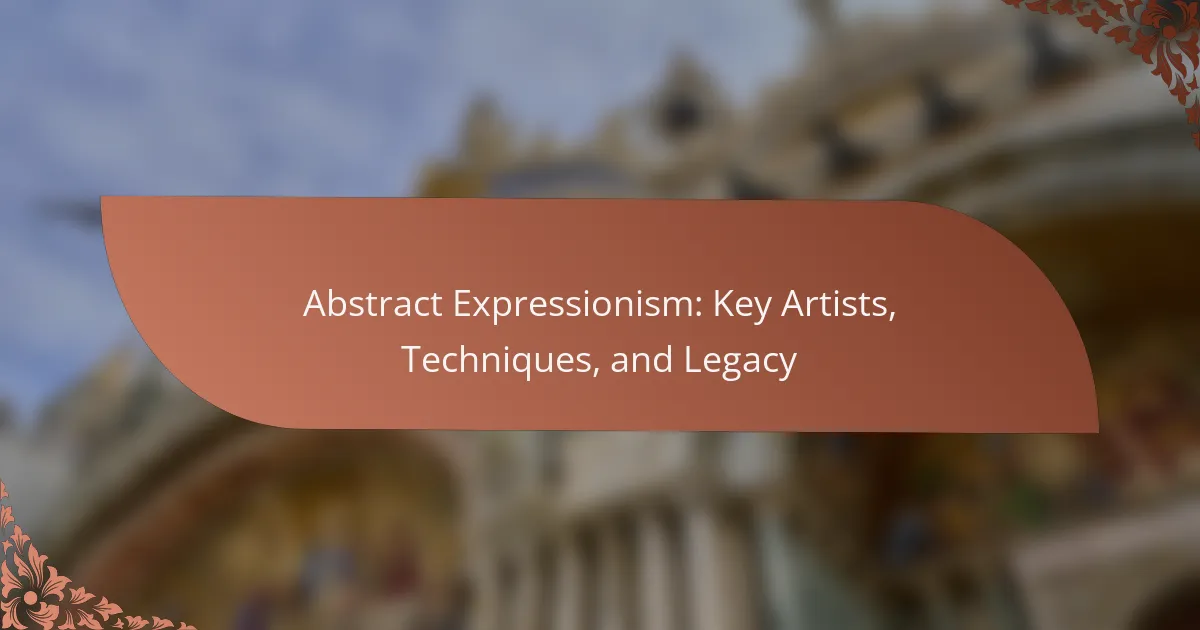Abstract Expressionism revolutionised the art world by prioritising emotional intensity and individual expression. This article explores key artists like Jackson Pollock and Mark Rothko, their innovative techniques such as action painting and colour field painting, and the lasting legacy of the movement in contemporary art. Understanding these elements sheds light on the evolution of modern artistic practices.
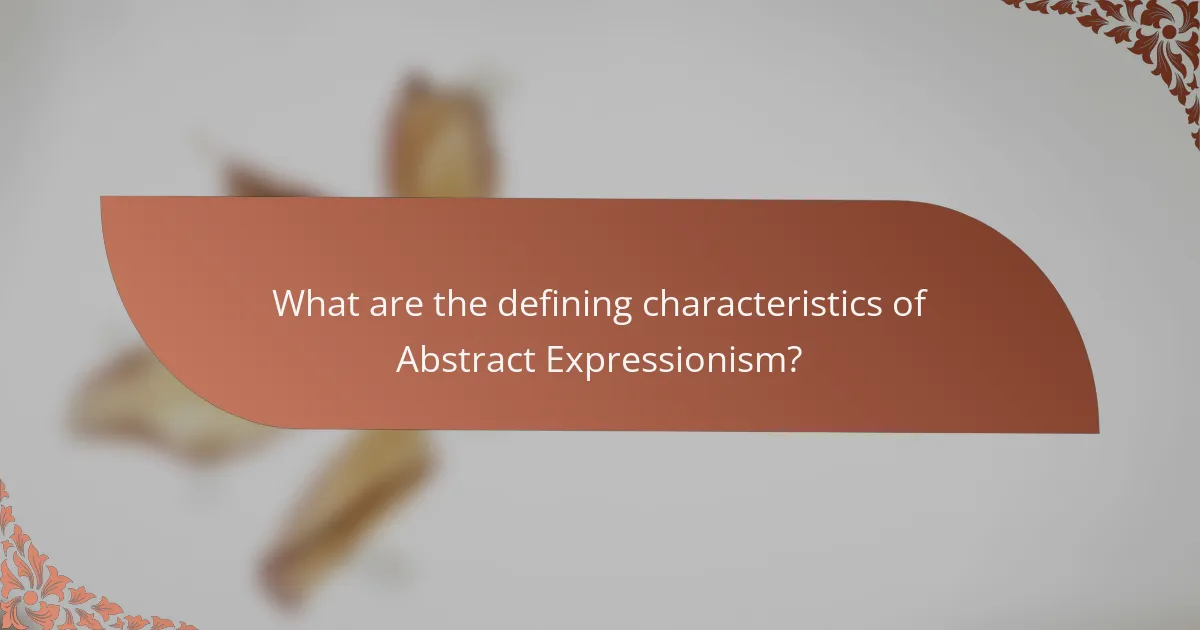
What are the defining characteristics of Abstract Expressionism?
Abstract Expressionism is characterised by spontaneous, automatic, or subconscious creation. Key artists include Jackson Pollock and Mark Rothko, known for their unique styles and techniques. The movement emphasises emotional intensity, abstraction, and individual expression, often utilising large canvases and vibrant colours. Its legacy influences contemporary art, promoting freedom of expression and experimentation.
How did the socio-political context influence Abstract Expressionism?
The socio-political context significantly influenced Abstract Expressionism, shaping its themes and techniques. Post-World War II America experienced a surge of existential anxiety and a desire for individual expression. Artists sought to convey emotional depth and personal experience, reflecting societal turmoil. The Cold War era provided a backdrop of tension, prompting artists to explore freedom and individuality as a response to authoritarianism. Moreover, the rise of consumer culture and mass media impacted artistic practices, leading to innovative techniques that emphasised spontaneity and abstraction. Key figures like Jackson Pollock and Mark Rothko became emblematic of this movement, using their art to comment on the complexities of modern life.
Which techniques are commonly associated with Abstract Expressionism?
Abstract Expressionism commonly employs techniques such as action painting, colour field painting, and gestural brushwork. Action painting emphasises spontaneous, dynamic strokes, while colour field painting focuses on large areas of colour to evoke emotion. Gestural brushwork captures the artist’s physical movement, enhancing the artwork’s emotional intensity.
What role does spontaneity play in Abstract Expressionism?
Spontaneity is central to Abstract Expressionism, fostering authentic emotional expression. Artists like Jackson Pollock and Willem de Kooning embraced improvisation, allowing instinct to guide their work. This approach resulted in dynamic compositions that reflect the artists’ inner experiences. The spontaneous techniques used often led to unique, one-of-a-kind artworks that defy traditional methods. As a result, spontaneity remains a defining characteristic of the movement’s legacy.
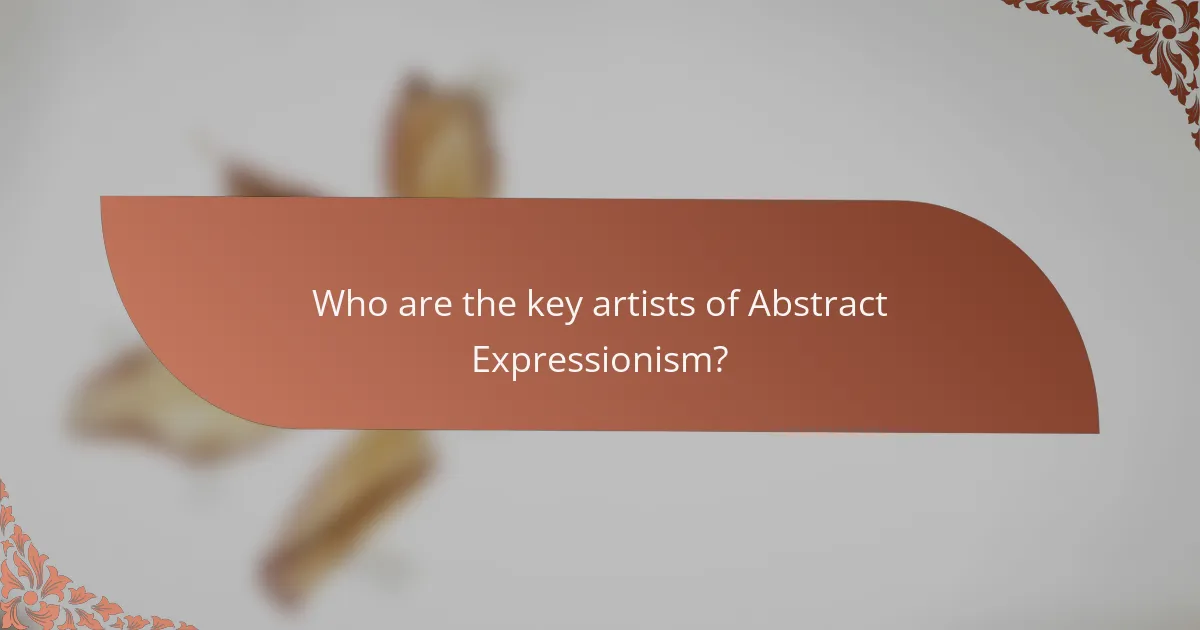
Who are the key artists of Abstract Expressionism?
Key artists of Abstract Expressionism include Jackson Pollock, Mark Rothko, Willem de Kooning, and Franz Kline. These artists pioneered techniques like action painting and colour field painting, significantly influencing modern art. Pollock’s drip painting method exemplifies the movement’s spontaneous energy. Rothko’s large colour fields evoke emotional responses, demonstrating the unique attribute of abstraction in conveying feelings. Their legacy continues to inspire contemporary artists and movements worldwide.
What contributions did Jackson Pollock make to Abstract Expressionism?
Jackson Pollock significantly shaped Abstract Expressionism through his innovative drip painting technique and emphasis on spontaneity. His work emphasised the act of painting itself, transforming the canvas into a dynamic space. Pollock’s unique approach allowed for emotional expression and movement, establishing a new artistic language. His influence persists, redefining the boundaries of modern art and encouraging future generations to explore abstraction.
How did Mark Rothko’s work differ within the movement?
Mark Rothko’s work stood out in Abstract Expressionism through his focus on colour and emotional depth. Unlike many peers who emphasised dynamic brushwork, Rothko created large, luminous colour fields that evoke introspection. His unique approach aimed to elicit profound emotional responses, distinguishing his art from the more action-oriented techniques of other artists in the movement. Rothko’s rare ability to blend simplicity with complexity in colour composition further solidified his legacy within Abstract Expressionism.
Which lesser-known artists significantly impacted Abstract Expressionism?
Artists like Franz Kline, Willem de Kooning, and Robert Motherwell, though lesser-known, significantly shaped Abstract Expressionism. Kline’s bold brushstrokes emphasised spontaneity, while de Kooning’s dynamic forms blurred the lines between abstraction and representation. Motherwell’s contributions included a focus on the emotional content of colour and form. Their unique approaches enriched the movement’s diversity and depth, showcasing how individual styles can impact collective artistic expression.

What are the primary techniques used in Abstract Expressionism?
Abstract Expressionism employs techniques like action painting, colour field painting, and gestural abstraction. Action painting emphasises spontaneous, dynamic brushwork, exemplified by Jackson Pollock’s drip techniques. Colour field painting focuses on large areas of colour to evoke emotional responses, as seen in Mark Rothko’s works. Gestural abstraction captures the artist’s physical movement, creating expressive forms. These techniques collectively define the movement’s emphasis on individual expression and emotional intensity.
How does action painting exemplify Abstract Expressionist techniques?
Action painting exemplifies Abstract Expressionist techniques through spontaneous brushwork and emotional intensity. Artists like Jackson Pollock and Willem de Kooning emphasised the act of painting as an expressive process. This approach often involved large canvases and dynamic movements, allowing artists to convey their subconscious feelings. The unique attribute of action painting lies in its focus on the physical act of creation, transforming the canvas into a site of performance. As a result, the viewer experiences the energy and emotion embedded in each stroke, making the artwork a reflection of the artist’s inner world.
What is the significance of colour field painting in Abstract Expressionism?
Colour field painting is significant in Abstract Expressionism as it emphasises emotional resonance through large expanses of colour. Artists like Mark Rothko and Barnett Newman focused on colour’s psychological impact rather than representational forms. This technique allowed for a more direct emotional experience, fostering deep viewer engagement. The legacy of colour field painting continues to influence contemporary art, highlighting the importance of colour as a primary medium of expression.
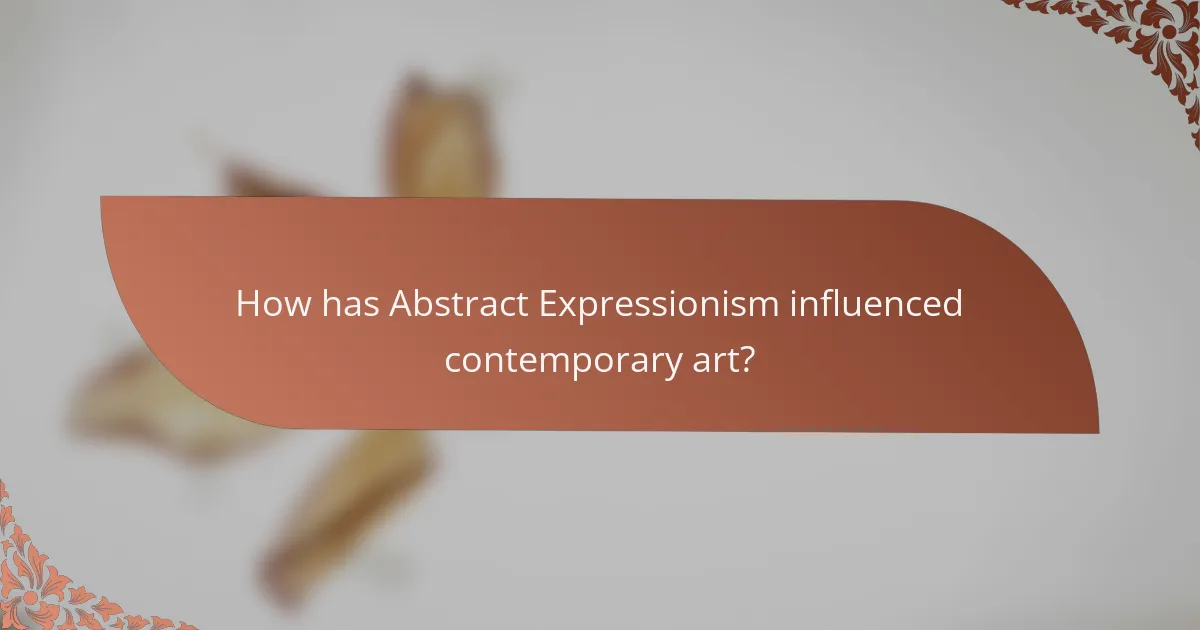
How has Abstract Expressionism influenced contemporary art?
Abstract Expressionism has profoundly influenced contemporary art by emphasising personal expression and abstraction. Key artists like Jackson Pollock and Mark Rothko pioneered techniques that prioritise spontaneous creativity. Their legacy is evident in various contemporary movements, including minimalism and conceptual art. Abstract Expressionism’s focus on emotion and individual perspective continues to inspire artists today, fostering a diverse range of styles and approaches.
In what ways do modern artists incorporate Abstract Expressionist elements?
Modern artists incorporate Abstract Expressionist elements through spontaneous brushwork, vibrant colours, and emotional intensity. They often emphasise personal expression and the act of creation itself, embracing techniques like drip painting and layering. Notable contemporary artists, such as Julie Mehretu and Mark Bradford, blend these methods with their unique styles, reflecting diverse themes and cultural narratives. This fusion highlights Abstract Expressionism’s lasting influence on today’s art landscape.
Which art movements were inspired by Abstract Expressionism?
Several art movements were inspired by Abstract Expressionism, including Colour Field Painting, Minimalism, and Neo-Expressionism. Colour Field Painting emphasises large areas of colour, while Minimalism focuses on simplicity and form. Neo-Expressionism revives emotional intensity and figurative elements. Each movement reflects Abstract Expressionism’s influence in unique ways, showcasing its profound legacy in contemporary art.
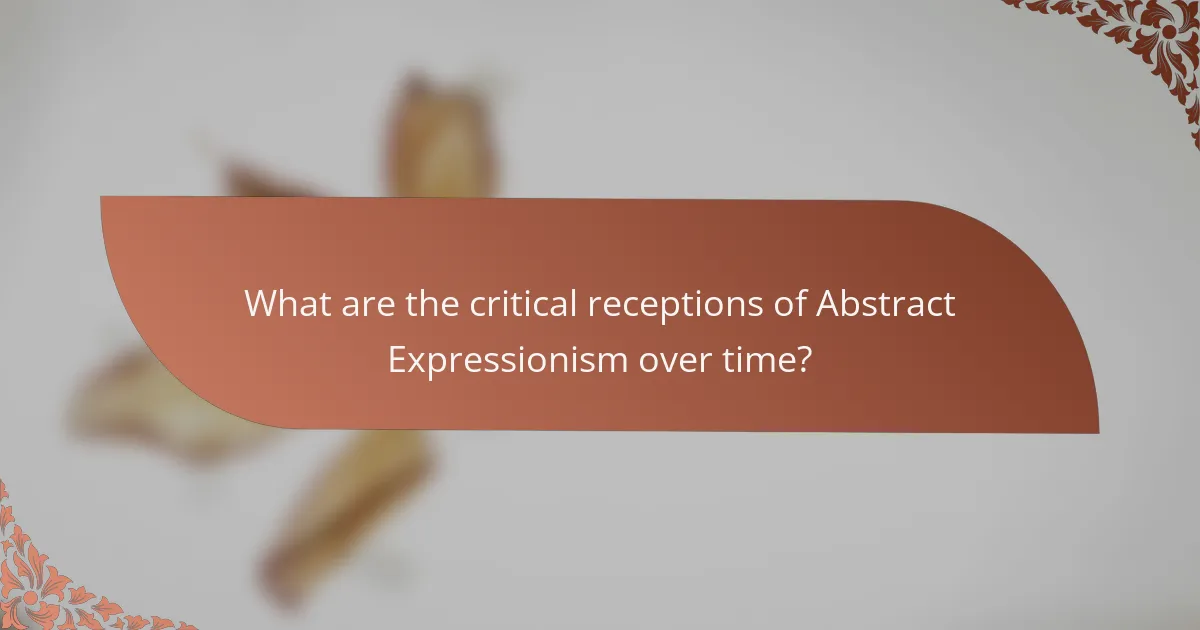
What are the critical receptions of Abstract Expressionism over time?
Critical receptions of Abstract Expressionism have evolved significantly since its emergence in the mid-20th century. Initially, critics were divided; some hailed it as a groundbreaking movement while others dismissed it as chaotic. Over time, appreciation grew as artists like Jackson Pollock and Mark Rothko gained recognition for their innovative techniques and emotional depth.
In the 1950s, Abstract Expressionism was celebrated for its departure from traditional forms, emphasising personal expression and spontaneity. Critics began to acknowledge its influence on subsequent art movements, such as Minimalism and Pop Art. However, by the late 20th century, some critics argued that the movement had become overly commercialised, leading to debates about authenticity and artistic value.
Today, Abstract Expressionism is regarded as a pivotal moment in art history, with its legacy influencing contemporary artists. Museums and exhibitions continue to showcase its key figures, solidifying its status as a foundational movement in modern art.
How have perceptions of Abstract Expressionism evolved in different cultures?
Perceptions of Abstract Expressionism vary across cultures, reflecting diverse interpretations and influences. In the United States, it is celebrated as a symbol of artistic freedom and innovation. Conversely, in Japan, it is often viewed through the lens of traditional aesthetics, integrating elements of Zen philosophy. European perspectives tend to emphasise the movement’s historical context, linking it to post-war existentialism. In Latin America, artists have adapted Abstract Expressionism to express local identities and political issues. This evolution showcases how cultural backgrounds shape the understanding and appreciation of art movements.
What criticisms have been leveled against Abstract Expressionism?
Critics have argued that Abstract Expressionism lacks formal structure and is overly subjective. Some view it as elitist, dismissing its emotional depth as mere chaos. Others claim it prioritises individual expression over collective cultural narratives. Additionally, its commercialisation has raised concerns about authenticity in art.
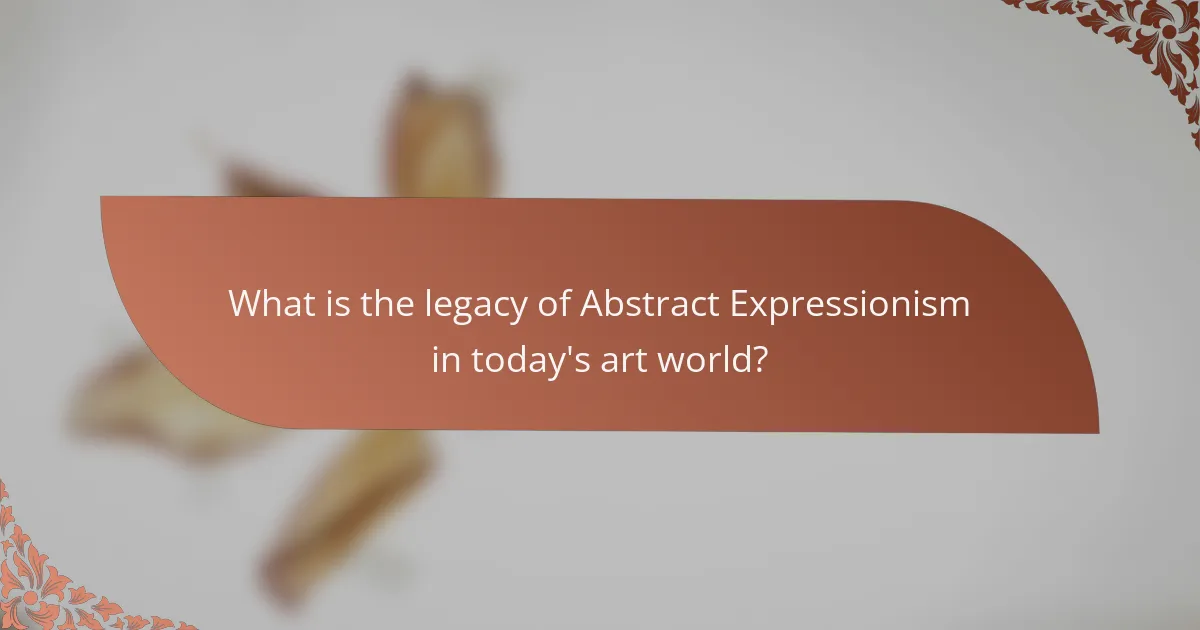
What is the legacy of Abstract Expressionism in today’s art world?
Abstract Expressionism has profoundly influenced contemporary art through its emphasis on emotion and individual expression. Its legacy manifests in various art forms, including performance art and installations, where spontaneity and abstraction remain central. Key artists like Jackson Pollock and Mark Rothko set the foundation for exploring personal and societal themes. Today, many artists draw inspiration from their techniques, pushing boundaries and redefining artistic expression. The movement’s impact is evident in the ongoing exploration of identity and experience within modern artistic practices.
How is Abstract Expressionism represented in museums and exhibitions?
Abstract Expressionism is prominently represented in museums and exhibitions through curated collections and thematic displays. Key artists like Jackson Pollock and Mark Rothko are often featured, showcasing their innovative techniques and emotional depth. Museums utilise immersive installations to engage visitors, allowing them to experience the movement’s spontaneity. Additionally, travelling exhibitions expand access to regional audiences, fostering a broader appreciation of Abstract Expressionism’s legacy.
What are the best practices for appreciating Abstract Expressionism?
To appreciate Abstract Expressionism, engage with its emotional depth and spontaneity. Focus on key artists like Jackson Pollock and Mark Rothko, exploring their techniques and distinct styles. Analyse the use of colour, form, and texture, as well as the historical context that influenced the movement. Attend exhibitions and discussions to gain diverse perspectives and deepen understanding.
Which common mistakes should be avoided when interpreting Abstract Expressionist works?
Avoiding common mistakes when interpreting Abstract Expressionist works enhances appreciation and understanding. Key errors include overanalysing symbolism, neglecting emotional responses, and disregarding the artist’s context. Misinterpreting spontaneity as randomness can also lead to confusion. Additionally, failing to consider the materiality and technique used can obscure the work’s intent.
